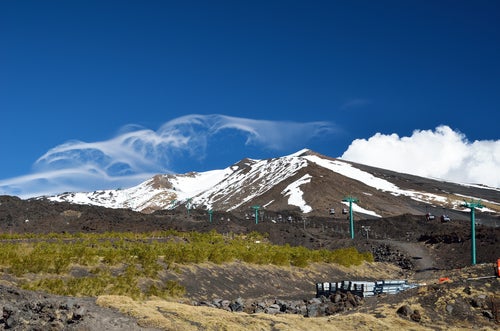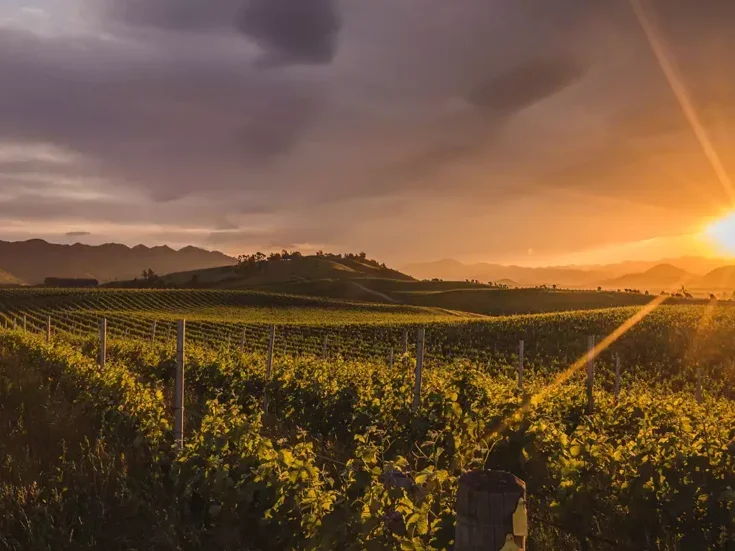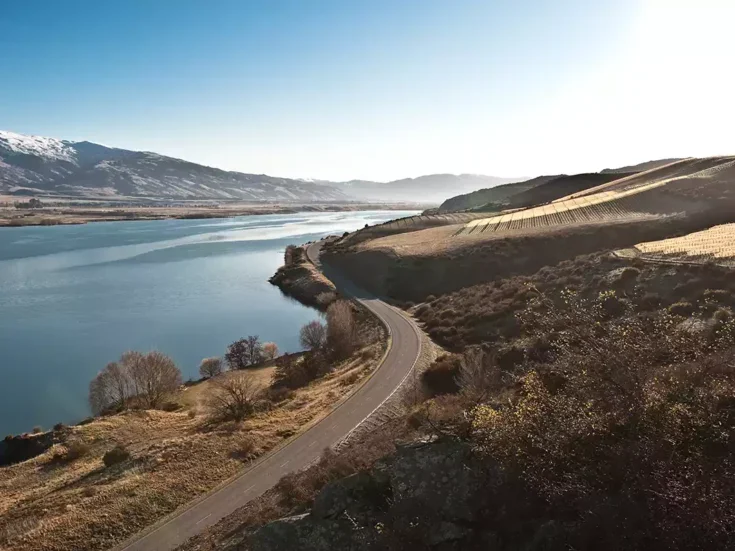
After attracting international attention to their distinctive wines and extraordinary collection of very old vines, Etna’s winemakers are increasingly exploring the specifics of their contrade in single-vineyard bottlings.
Shivering in the sub-zero temperature, I listened to the guide describing Mt Etna’s various eruptions. But the gale which blew the sleet horizontally carried his words away into the misty vacuum of the crater.
It was warmer down at 800m (2,620ft) but very wet. Climate change had brought an unseasonal deluge of rain in May to Etna’s north side which is typically dry. Extreme weather and heroic viticulture are par for the course here but this usually refers to the cultivation of bush vines, dwarfed by age, in the austere and dry growing conditions on the slopes of an active volcano.
The windy north side of Etna is sufficiently warm to ripen the skins of Nerello Mascalese. It also has a significant diurnal shift which embraces the variety’s need for a long season to reach full phenolic ripeness, while retaining bright acidity. Giuseppe Russo has his fair share of ungrafted old vines for much of his Nerello Mascalese was planted 90 years ago.“The age of Nerello Mascalese and the variety of biotypes contribute to the richness of our area,” he observes.
When Giuseppe left his career as a classical pianist and history teacher in 2003, following the death of his father Girolamo, he took time to “discover the different parcels of vines. I fell in love with the vineyards and made single-vineyards (contrade) from the beginning. My first contrada wine was San Lorenzo, which was first bottled in 2005, although it was illegal to label it as a single-vineyard at the time. Tenuta delle Terre Nere labelled a single-vineyard just before I did, with the 2002.”
“Not all old vines are good,” he adds candidly. He uses younger vines and experimental micro-vinfications for his fresh, smooth, pretty A Rina blend, which is aged in concrete. Not that he would describe A Rina as entry-level. “With my approach, that is not possible.”
As interesting as A Rina is, I had come to North Etna to concentrate on contrada wine and was keen to discover how Giuseppe’s old vines express the terroir in the five single-vineyard wines he produces. There are 133 contrade in the Etna DOC, which was created in 1968 and amended in 2011. Giuseppe’s vineyards are scattered across the municipalities of Castiglione di Sicilia and its western neighbor Randazzo, where there are 72 contrade, which attests to their significance on the northern side of Etna.
Exploring Etna’s contrade
In Contrada Feudo di Mezzo (in Castiglione di Sicilia) Giuseppe has a 1.3ha (3.2 acres) parcel largely made up of century-old bush (alberello) vines. This is his oldest vineyard and was passed down from his grandfather, although over the course of a century some vines have died and been replaced with a layering technique. There are two parcels—one at 630m (1,970ft) and the other at 670m (2,200ft)—both located towards the top of the contrada, but on different soils formed by separate volcanic eruptions. The parcel on soil from the most recent eruption in 1676 is clay rich. Giuseppe uses spontaneous fermentation for all his contrade wines which are aged in second-fill tonneau and barrique. Feudo di Mezzo 2022, a warm and dry vintage, is juicy and generous with an abundance of red fruit. “This is my idea of Nerello Mascalese from North Etna for the smell and structure is a bit wild,” muses Russo. “Maybe because this is the vineyard my father vinified, so it is the smell of my childhood.”
In Contrada Calderara Sottana, which straddles the border of both municipalities, Giuseppe inherited 1ha (2.4 acres) from his uncle. This has 65-year-old vines and tiddlers of 5 years old—clones propagated from a selection of his best old vines. Calderara Sottana is higher on the slope at 700m (2,300ft) above sea level, on an older pumice soil. I find the 2022 is more savory and silty than Feudo di Mezzo and slightly crunchy, although Giuseppe Russo says it’s silky.
I particularly liked the wine from Contrada Feudo in Randazzo. A slightly lower contrada at 630m (2,070ft), this is another of his grandfather’s vineyards (65-to-70-year-old vines) co-planted with some Nerello Cappuccio which his father used to replace vines which had died. Feudo has a particularly deep soil and breezy microclimate. The 2022 smells of fresh earth and the herby, cocoa-powder palate, with its firm, edgy tannins and crisp snap, is attractively austere. The 2021 is even better, crushed-glass tannin, somewhat more refined and saline. Feudo is aged largely in 2,500l (660 gallons) foudres. According to Giuseppe, “the 2021 is a classic vintage, one of the best in recent years.”
We took a walk through Contrada San Lorenzo on the outskirts of Randazzo village which lies on the far west of North Etna’s vineyards. Giuseppe tells me it is made as a single-vineyard wine by four producers, but there are marked differences between the lower, middle, and top sections. San Lorenzo rises from 700–800m (2,300–2,620ft) and Giuseppe’s parcel is once again situated towards the top at 750m (2,460ft). It has a calcium-rich, sub-alkaline soil which Giuseppe describes as “the most complex soil; the product of a more explosive eruption.” It is a pebbly soil through which chunks of mother rock protrude. “San Lorenzo has the best balance of stones, sand, and organic matter while Fuedo has a higher percentage of small stones.”
Girolamo bought this vineyard in 1991. It was planted on wide terraces some 80-85 years ago and the wine it produces is the richest among Giuseppe’s single-vineyard wines, both fuller and sweeter with velvet tannins. In the best years, just four to date, Giuseppe has made a separate bottling from a 0.6ha (1.5 acres) parcel where the fruit always ripens earlier. This cuvée is called Piano delle Colombe after the doves which are attracted to its luscious grapes. Piano delle Colombe 2021 is a level up in concentration and depth from the classic San Lorenzo. It is suave, seductively fruity, and texturally svelte with a persistent satin-rich finish.
Giuseppe is keen to point out that the contrade are large and the terroir within each is diverse. Calderara Sottana for example scales 500-700m (1,640–2,300ft). The contrade were delimited along cultural, historical, and geographic lines rather than by soil and microclimate. Roads have been used as borders and a disused railway track defines one edge of Feudo. In other contrade the sciara (lava flows which have cooled and solidified) determine the boundaries, some of which have been redrawn following recent eruptions. Giuseppe comments there is still much to be learnt about the soil on Etna “which is changing continuously.” He believes the more explosive eruptions have created a softer, more fragile and lightweight soil capable of being cultivated sooner than the lava soils from a weaker eruption which are more solid. “Just my theory,” he says, “not a certainty.”
Vast scale
Just consider—it is a mere 20 years since the modern phase of wine production began on Etna after many years of neglect. So while the contrade of North Etna are certainly more tightly defined than the southwest, where they are vast, it is not possible to compare contrade with the evolution of climats over hundreds of years of continual viticulture in Burgundy. So while I found it fascinating to taste such different wines from Giuseppe’s contrade, in no way do they represent an expression of the whole vineyard.
In the Contrada Santo Spirito, beside Feudo di Mezzo, I visited Anima Etnea owned by the Moretti family from Tuscany. They have invested the proceeds of their fashion business into five small wineries in Tuscany and Sicily, including, in 2010, this north-facing estate in Santo Spirito. The property came with 1.2ha (3 acres) of 90-year-old vines situated on a terrace at 650m (2,130ft). They have planted a further 7.5ha (18.5 acres), including their striking new amphitheater vineyard, where they have young vines of Nerello Mascalese in a bowl created by the lava flow. This is quite a bit higher at 800m (2,620ft).
Anima Etnea Animardente is a blend of parcels, including the new plantings. It has a minty, floral, and yet earthy perfume and attacks with a burst of sweetness. There’s tannic grip, bitter cherry stone, and a sapid finish. An attractive and energetic wine for sure, but there’s a significant leap in quality to Animantico from the old vines. The 2022 is fermented for 15 days in up-ended 500l (130 gallons) barrels in which the cap is pushed down by hand. The wine is restrained and savory with a hint of lemon thyme. It’s dense, yet sparse. I like the silky fluidity and focus.
Moving to the east side of Castiglione di Sicilia, Tenuta di Fessina has a northeast-facing parcel at 640m (2,100ft) in Contrada Moscamento. The boundaries of their parcel were formed by the 1911 lava flow when eight craters opened up on the north face of Etna. This has created a nested vineyard, which during my visit glowed in the light of the setting sun. It is quite a warm sheltered spot, the lava flows act rather like the walls of a clos, creating a subtle micro-environment. Jacopo Maniaci, joint-owner and winemaker, explained the soil at the top is thick and solid with iron oxide and basalt, while the lower part has 8m (26ft) of deep sandy clay. The vines were planted in 1921 and 1932.
We tasted magnums of Il Musmeci 2011 and 2018 from this vineyard. Although the 2011 was rather extracted and dry, between these vintages Jacopo has changed the vinification. The temperature is capped at 27°C (81°F) and the maceration at 12–14 days. The 2018 is a delight. Pure and delicate, fine-boned wine. Undoubtedly the cold 2018 season has contributed to the crisp and crystalline profile, but Jacopo describes it as “a true portrait of my vineyard.”
Contrade wines are increasingly popular. Where Giuseppe Russo has led many have followed, exploring the rich diversity of their terroir. The profile and reputation of Etna’s wines has soared over the past two decades with international interest riveted by Etna’s extraordinary patrimony of old vines. As the region settles into a more mature phase, the process of understanding and expressing the character of their contrade will undoubtedly keep Etna in the limelight.






